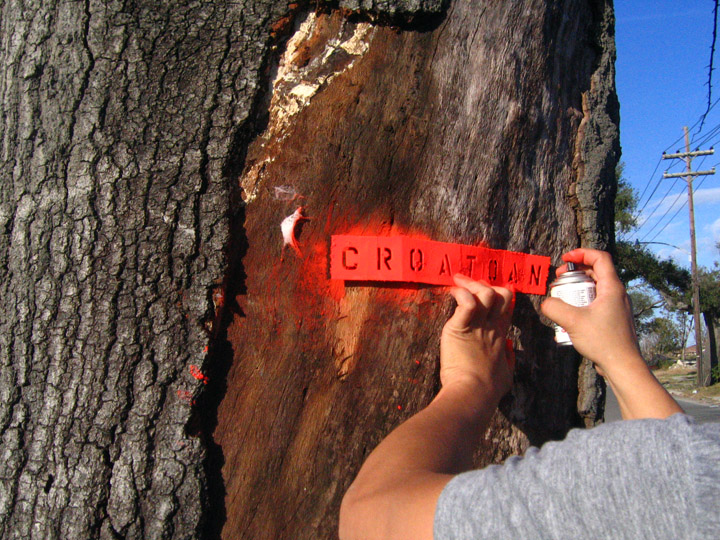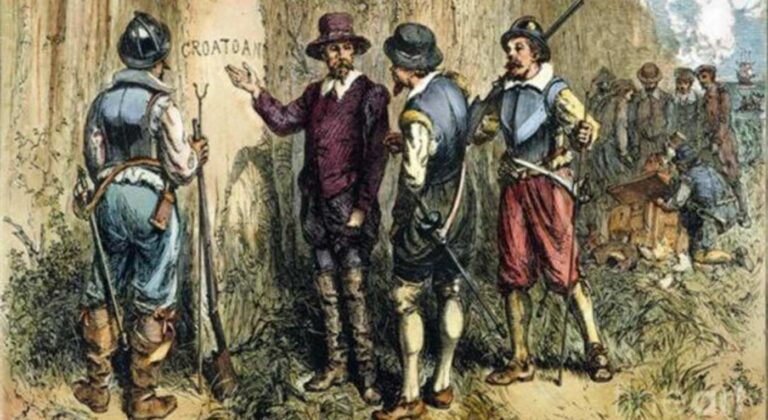Picture a distant island, bathed in the soft light of the setting sun, shrouded in the mystique of centuries-old oaks and whispering winds. This is Roanoke Island, a place that holds within its embrace one of the most profound mysteries in the annals of American history—the enigma of the Lost Colony. In this voyage through time and legend, we step onto the shores of Roanoke Island to unravel the tale of a vanished community, leaving behind a trail of unanswered questions and an enduring riddle that continues to captivate our collective imagination.
Our journey begins in the late 16th century, an era marked by a fervent spirit of exploration and discovery. England, driven by ambition and the allure of the New World, dispatched explorers to the distant shores of what would one day become the United States. Among these intrepid souls was the renowned Sir Walter Raleigh, who, in 1585, established a settlement on the pristine shores of Roanoke Island, situated off the coast of what we now know as North Carolina.
The settlers who stepped onto the soil of Roanoke Island were pioneers, courageous souls who left behind the comforts of their homeland to forge a new existence in the uncharted territories of the Americas. Their arrival marked the beginning of an epic narrative—one that would entwine with the fabric of American history and leave behind a tapestry of unanswered questions.
Life on Roanoke Island, however, was far from the idyllic vision of a new beginning. The colonists grappled with a barrage of challenges, from the unforgiving elements of nature to the strained relations with indigenous Native American tribes. Their very survival was a precarious balance, heavily reliant on the resources and support flowing from their distant homeland.
As tensions escalated and resources dwindled, a pivotal decision emerged. In 1586, facing a dire predicament, the settlers made the harrowing choice to return to England, leaving behind the promise of Sir Walter Raleigh’s swift return with supplies and support. Little did they know that their journey home would mark the beginning of a mystery that would endure for centuries.
It was not until 1590, after a haunting three-year delay due to England’s conflicts with the Spanish Armada, that a relief expedition led by John White, the colony’s governor, finally set foot on Roanoke Island. What they found—or rather, what they didn’t find—would leave an indelible mark on history.
Upon their arrival, the relief expedition discovered Roanoke Island eerily deserted. Structures and fortifications still stood, but the settlers had vanished without a trace. The only clues left behind were the cryptic markings “CROATOAN” carved into a tree and “CRO” etched into a fort’s palisade. The meaning of these inscriptions has puzzled historians and investigators for centuries.
The Roanoke Island mystery has transcended the boundaries of time, its enduring enigma captivating generations of history enthusiasts and amateur sleuths alike. Theories and speculations have multiplied, offering glimpses into possible scenarios that might explain the fate of the Lost Colony.
Some have proposed that the colonists sought refuge with the nearby Croatoan tribe, leading to the belief that they assimilated into Native American communities and adopted their way of life. Others have suggested scenarios involving conflict, violence, or relocation, each offering a unique perspective on the colonists’ mysterious disappearance.
Despite the efforts of modern researchers and archaeologists, the Roanoke Island mystery remains a conundrum with missing pieces. Archaeological excavations, scientific analyses, and historical research have provided tantalizing hints but no definitive answers.
The tale of Roanoke Island, the Lost Colony, is not simply a historical curiosity; it is an enduring legend that has left an indelible mark on American culture and folklore. It continues to inspire novelists, historians, filmmakers, and artists who are drawn to the mystery of the vanished settlers.
As we embark on this voyage into the heart of the Roanoke Island mystery, we are invited to explore, question, and wonder. The cryptic carving of “CROATOAN” and the elusive settlers beckon us to unravel the enigma, to peer into the past, and to contemplate the mysteries that linger just beneath the surface of history.
In the end, the Lost Colony serves as a testament to the inexhaustible power of human curiosity and the timeless allure of mysteries. It is a reminder that, no matter how much we uncover in the annals of history, there are always questions that challenge our understanding, beckoning us to delve deeper into the shadows of the past and to seek the truth that eludes us.
The Arrival of the Lost Colony

Our story begins in the late 16th century, a time of great exploration and expansion. England, eager to stake its claim in the New World, sent expeditions across the Atlantic Ocean. Among them was the famed explorer Sir Walter Raleigh, who in 1585 established a settlement on Roanoke Island, located off the coast of present-day North Carolina.
The settlers who arrived on Roanoke Island were the vanguard of what would become known as the Lost Colony. They braved the uncertainties of the New World, hoping to establish a foothold for England and secure a prosperous future. Their arrival marked the beginning of an enduring legend—one that would continue to captivate the imagination for centuries to come.
Mysterious Departures
Life on Roanoke Island was far from idyllic. The colonists faced a myriad of challenges, including harsh weather, limited supplies, and strained relations with local Native American tribes. The settlers’ dependence on England for resources and reinforcements made their situation precarious.
In 1586, tensions escalated, and the settlers’ plight became increasingly dire. With supplies running low and relations with Native Americans deteriorating, they made the fateful decision to return to England. Sir Walter Raleigh, their sponsor, left them with a promise to return soon and provide support.
The Vanishing Act
The return to England brought a mixture of relief and uncertainty for the colonists. However, their hopes for a swift return to Roanoke Island were dashed when England became embroiled in conflicts with the Spanish Armada. Sir Walter Raleigh’s efforts were diverted, and the colonists were left in limbo.
It wasn’t until 1590, after a three-year delay, that a relief expedition led by John White, the colony’s governor, finally arrived at Roanoke Island. What they discovered would baffle and haunt generations of historians and mystery enthusiasts.
The Cryptic Clue
Upon their arrival, the relief expedition found Roanoke Island deserted. Buildings and fortifications still stood, but the colonists were nowhere to be found. The only clue left behind was the words “CROATOAN” carved into a tree and “CRO” carved into a fort’s palisade.
The meaning of these markings remains a subject of debate. “CROATOAN” referred to a nearby island and a local Native American tribe, sparking theories that the colonists may have sought refuge with the tribe. However, despite extensive searches and inquiries, the fate of the Lost Colony remained shrouded in mystery.
Theories and Speculations
The Roanoke Island mystery has fueled countless theories and speculations over the centuries. Some of the most prominent theories include:
- Integration with Native Americans: The theory that the colonists integrated with the Croatoan tribe and were assimilated into Native American communities, adopting their way of life.
- Conflict and Violence: Speculation that the settlers may have faced violence or conflict, leading to their disappearance or death.
- Relocation: The idea that the colonists may have attempted to relocate to another area and ultimately perished in the harsh wilderness.
- Starvation and Disease: The possibility that the settlers succumbed to starvation, disease, or other hardships, leading to their demise.
Each theory offers a different perspective on the fate of the Lost Colony, but none provides a definitive answer.
Ongoing Investigations and Discoveries
The Roanoke Island mystery has not faded with time. Modern researchers and archaeologists have continued to explore the island and its surroundings, seeking clues that might shed light on the fate of the Lost Colony. Their efforts have resulted in some fascinating discoveries:
- Archaeological Excavations: Ongoing excavations have unearthed artifacts and structures that may have belonged to the settlers, offering tantalizing hints about their lives and activities.
- Scientific Analysis: Scientific techniques such as DNA analysis of Native American populations have sought to trace potential descendants of the colonists.
- Historical Research: Meticulous historical research and analysis of documents have aimed to piece together the events leading to the colonists’ disappearance.
Despite these efforts, the mystery of the Lost Colony remains a puzzle with missing pieces.
The Legacy of Roanoke Island
The legacy of Roanoke Island endures, leaving us with more questions than answers. The story of the Lost Colony has been passed down through generations, becoming an integral part of American folklore and history. It continues to be a source of fascination and intrigue, captivating the imaginations of those who encounter it.
The cryptic “CROATOAN” carving and the disappearance of the settlers continue to inspire novelists, historians, and filmmakers. The story of the Lost Colony is woven into the fabric of American culture, a testament to the enduring allure of mysteries.
The Invitation to Explore
The mystery of Roanoke Island, the Lost Colony, extends an alluring invitation—an invitation to embark on a journey that transcends time and place. It beckons us to venture into the realms of exploration, inquiry, and wonder, daring us to confront the gaps that punctuate our knowledge and challenge our understanding. In the heart of this centuries-old enigma, we find not only a profound historical puzzle but a reflection of the insatiable human thirst for discovery and truth.
As we peer into the murky depths of the past and ponder the fate of those intrepid early settlers, we are reminded that the quest for answers is an intrinsic facet of our human experience. It is an innate drive that has propelled us forward through the eons, pushing us to unravel the mysteries that have shrouded our existence and shaped our history. The Roanoke Island mystery encapsulates this quest, compelling us to seek the truth, untangle enigmas, and forge deeper connections with the rich tapestry of our past.
In essence, the Lost Colony serves as a testament to the enduring potency of curiosity, a force that has driven humanity to new heights of understanding and exploration. It underscores the boundless potential for discovery that remains ever-present, just beyond the horizon of our knowledge. The cryptic carving of “CROATOAN” and the evanescent settlers cast a spell upon us, inviting us to journey into the unknown, to pose questions that challenge the boundaries of our understanding, and to stand in awe of the mysteries that beckon from the uncharted realms of history.
As we embark on our odyssey into the heart of the Roanoke Island mystery, we are called to embrace the legacy of those who came before us, those who ventured into the untamed wilderness of the New World, and those who left their indelible mark upon the annals of history. They remind us that, in the face of enigma and uncertainty, the human spirit is driven to explore, question, and wonder—a legacy that endures through the ages and remains as vibrant and compelling as ever.

